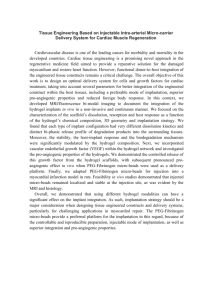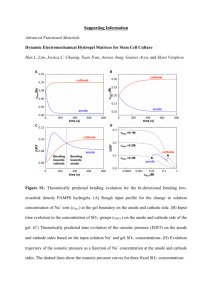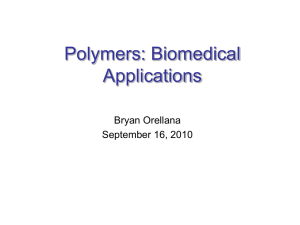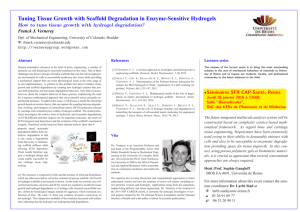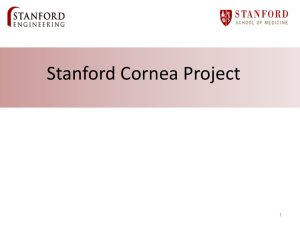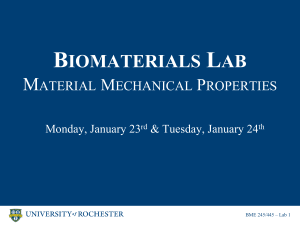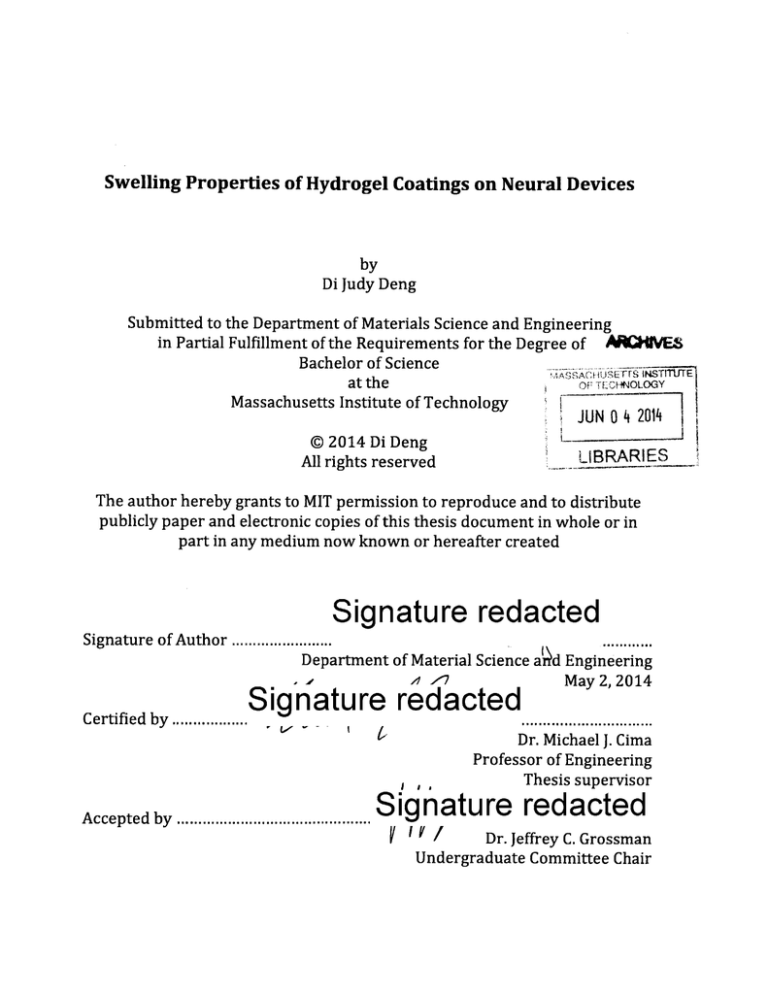
Swelling Properties of Hydrogel Coatings on Neural Devices
by
Di Judy Deng
Submitted to the Department of Materials Science and Engineering
in Partial Fulfillment of the Requirements for the Degree of AEIVES
Bachelor of Science
at the
at the
Massachusetts Institute of Technology
@ 2014 Di Deng
All rights reserved
TT
Fr~ INSTITUJTE
OF TECHNOLOGY
JUN 0 4 2U14
LIBRARIES
The author hereby grants to MIT permission to reproduce and to distribute
publicly paper and electronic copies of this thesis document in whole or in
part in any medium now known or hereafter created
Signature redacted
Signature of Author ........................
............
Department of Material Science and Engineering
e17
May 2, 2014
Certified by ..................
Signature redacted ...............................
I
L011-
-
'
Accepted by ..............................................
t
Dr. Michael J.Cima
Professor of Engineering
Thesis supervisor
Signat ire redacted
V I
I, /
Dr. Jeffrey C. Grossman
Undergraduate Committee Chair
Table of Contents
List of Tables .............................................................................................................................
3
List of Figures............................................................................................................................4
Abstract......................................................................................................................................5
1. Introduction..........................................................................................................................6
1.1. Significance
1.2. Hydrogels
1.3. Hydrogel Swelling
1.4. Elastic Moduli
2. M ethods...............................................................................................................................11
2.1. Materials
2.2. Preparation of Hydrogel
2.3. Preparation of Hydrogel Coating on Capillary
2.4. Gel Dependence on PEG MW and %PEG
2.5. Time Dependence of Swelling
3. Results.................................................................................................................................15
3.1. Gel Dependence on PEG MW and %PEG
3.2. Swelling Ratio of Hydrogel-Coated Capillaries
3.3. Time Dependence of Swelling
3.4. Vector Plot Observations
4. Discussion............................................................................................................................25
4.1. Gel Dependence on PEG MW and % PEG
4.2. Swelling Ratio of Hydrogel-Coated Capillaries
4.3. Time Dependence of Swelling
4.4. Vector Plot Observations
5. Conclusion...........................................................................................................................28
6. Acknowledgem ents.............................................................................................................29
7. References...........................................................................................................................30
2
List of Tables
Table 1 Structure of three forms of poly (ethylene glycol) polymers.........................9
Table 2 Summary of swelling parameters for different hydrogel formulations..............15
Table 3 Average parameters for hydrogel-coated capillary (10%, 700 MW PEG-DA) ...... 19
3
List of Figures
Figure 1
Photo-polymerization generates free radicals to initiate the polymerization process.
Final representation of the hydrogel is idealized............. ...........................
8
Figure 2 a) capillary tubes are treated with piranha solution to hydroxylate the surface b)
capillary tubes are functionalized with methacrylate groups using TPM c) poly
(ethylene glycol)- dimethacrylate polymer chains are introduced d) exposure to UV
light starts a photo-polymerization process that allows the methacrylate end groups of
the polymer chains to bond to the surface and crosslink with each
other.........................................................................................
. . 12
Figure 3 Increased polymer concentrations leads to increased crosslink densities. Increased
molecular weights of PEG leads to increased molecular weight between
crosslinks.......................................................................................
16
Figure 4 Estimated elastic modulus for different hydrogel formulations. Increasing the polymer
concentration is an effective way to change the elastic modulus.....................17
Figure 5 Capillary is not centered within the hydrogel after the fabrication process. The overall
cross-section of the hydrogel is still assumed to be spherical due to the shape of the
mold. During re-swelling, the side with a thinner layer of hydrogel reaches
equilibrium first..............................................................................
18
Figure 6 a) Initial swollen hydrogel at equilibrium, b) Dried hydrogel c) Swollen gel after 1
m inute of re-sw elling. .........................................................................
19
Figure 7 When the hydrogel is inserted into the brain phantom without dehydration, the
hydrogel shears off and the coating is compromised.......................................20
Figure 8 Time course for the swelling of a 10% 700 MW hydrogel coated capillary in water
versus agarose................................................................................
20
Figure 9 Time course for the swelling of 20% 700 MW hydrogel coated capillary in water
versus agarose. At around 125 seconds the gel has reached equilibrium............21
Figure 10 Time course for the swelling of 20% 700 MW hydrogel coated capillary in water
versus agarose for the first 125 seconds before the gel has hit equilibrium............22
Figure 11 a) capillary showing direction of implantation b) capillary after 300 seconds of
swelling in agarose c) sample vector plot for time interval of 2-4 seconds with white
lines indicating the capillary and gel boundaries d) 0-2s: large y displacement values
indicate agarose is moving along the direction of implantation e) 2-4s: large negative
y displacement values indicate agarose is readjusting back to its initial position f) 436s: displacement exponentially decays on the left side due to hydrogel expansion
while displacement linearly decreases on the right side due to agarose readjusting.
g/h) bulk of agarose is at equilibrium; all movement is due to agarose expansion....24
Figure 12 Buckling of the hydrogel occurred during swelling in some samples when the
hydrogel dried for extended periods of time............................................26
4
Abstract
Glial scarring is a major problem seen in brain electrode implants that can hinder electrode
function. One major contributing factor is the mechanical mismatch between the stiff electrode
and the soft brain tissue'. Hydrogel coatings are being investigated to determine their
effectiveness in providing the necessary biocompatibility. Polyethylene glycol hydrogels of
various formulations were fabricated and produced elastic moduli ranging from 13kPa to 687
kPa, which lie within two orders of magnitude of the elastic moduli of the brain (6kPa).
Dehydration of the hydrogels provides the mechanical rigidity necessary for implantation into
the brain. The surrounding aqueous environment allows the dried hydrogel to return to its
swollen state. The swelling process in the brain phantom is slower than in unconstrained
swelling. The equilibrium swollen hydrogel was also slightly smaller in the constrained state,
implying the strain is being distributed between the hydrogel and the brain phantom.
5
1. Introduction
1.1. Significance
Errors in chemical and electrical signal transmissions can lead to miscommunication
between different regions of the brain and cause circuit disorders. Treatments include deep
brain stimulation, which has proven to be effective for several disorders. This surgical
treatment allows scientists to electrically modulate and record brain activity in target regions
by implanting an electrode into specific areas of the brain i.
A large problem with device implantation into the brain is the brain tissue's response to
these implants. Research has suggested that the surrounding tissue will initiate an
inflammatory and wound healing response that is exacerbated over time as a result of the
brain's micro-motions from everyday movement. A fibrous capsule develops over time that
interferes with electrode and neuron cell body contact, which can negatively impact device
function".
Previous experiments have demonstrated a direct correlation between induced strains at
the probe-tissue interface and the resultant scarring, suggesting mechanical mismatch to be a
cause of scar formation"'. The elastic modulus of neural implants is often orders of
magnitude larger than that of the brain. Borosilicate glass and the brain have elastic moduli
of 69GPa and 6kPa, respectively. This mismatch causes the soft brain tissue to experience the
majority of the strain. When the modulus of the implant is reduced, more strain will be
shared between the device and the brain tissue. Subbaroyan et al showed through finite
element analysis that reducing the moduli of the implant to the scale of megapascals can
reduce the strain on the brain by two orders of magnitudes. This demonstrates a need for
mechanical compatibility between the device and the brain tissue to minimize the brain's
immune defenses and promote long-term usage of the device.
6
Coating neural probes with hydrogels is one potential approach to improve compatibility
with brain tissue and reduce the strain caused by micro-motions. One problem with a coating
is its adhesion strength to the capillary. Weak adhesion between the hydrogel and the
capillary can damage the hydrogel during implantation. This thesis studies the effectiveness
of using dehydration to preserve the hydrogel during implantation. It is hypothesized that a
dehydrated hydrogel can be safely implanted and rehydrated from the high water content of
the brain.
1.2. Hydrogels
Hydrogels are materials formed from a cross-linked network of polymer chains. A variety
of hydrogels can be developed by manipulating the polymer composition and the crosslinking mechanism. Crosslinks can be formed through both chemical and physical means.
The result is a hydrophilic material with unique mechanical and physical properties,
including the ability to imbibe water and swell. Many hydrogels have been developed that
are environmentally sensitive to factors such as pH, temperature, and ionic strength'.
Hydrogels are frequently used in bioengineering because they are easily modified and highly
biocompatible.
One frequently used mechanism for forming crosslinks is photo-polymerization.
The
process utilizes light and photo-initiators to induce free radical polymerization of molecules.
This method is beneficial because of its fast curing time, spatial and temporal control, and
ability to be conducted in ambient temperatures. This allows for the formation of hydrogels
on complex shapes, such as coatings on surfaces. The photo-polymerization process is
initiated when a photo-initiator molecule is exposed to a specific wavelength of light and
forms a radical species. The photo-initiator can be mixed into the hydrogel precursor solution
7
so that after activation, the radical species that are formed will cause the polymerization
process to proceed throughout the bulk of the solution to form the hydrogeliv (Figure 1).
Rad*+ H2C =
CH
-F
Rad-CH 2- CH
I
I
R
Rad-CH 2- CH'+
R
H2C
I
CH
I
-
Rad-CH 2-CH-
I
CH 2 -CH
I
Figure 1. Photo-polymerization generates free radicals to initiate the polymerization process. Final
representation of the hydrogel is idealized.
Polyethylene glycol (PEG) is a synthetic polyether that is biologically compatible due to
its low toxicity and hydrophillicity. It is frequently used in vivo because it does not activate
an immune response and prevents protein adhesion to surfaces. PEG chains can be easily
functionalized with terminal acrylate groups to form PEG-diacrylate or PEG-dimethacrylate
for cross-linking purposes v (Table 1).
8
Table 1
Structure of three forms of poly (ethylene glycol) polymers
Name
Structure
Poly(ethylene glycol)
H
-n
0
o
Poly(ethylene glycol) diacrylate
H2C
O
COH
2
C
-
0
0
0
H2C
Poly(ethylene glycol) dimethacrylate
CH2
1.3. Hydrogel Swelling
A useful property of hydrogels is their ability to swell when placed in a
thermodynamically compatible solvent. The tendency of systems towards higher entropy
states drives the thermodynamic force of mixing, which causes the hydrogel to expand. The
elastic force from the stretching polymer chains keeps the hydrogel together. The hydrogel
will continue to imbibe the solvent until the increase in elastic energy of the chains balances
the decrease in free energy from mixing. No additional swelling will occur and the hydrogel
will stay at equilibrium. This effect is described the Flory-Rehner equation which can be
rearranged to give an estimate of the average molecular weight between crosslinksv.
1
2
MC
Mn
(-ln
(1-v2,S)+v2,s+x*v2,s
1/
V2,S
V2,s'1
2
2
9
where Mn is the number average molecular weight of the polymer chains, v is the specific
volume of the bulk polymer in the amorphous state (0.893 cm 3/g)vii, V1 is the molar volume
of the solvent (18 cm3/mole), x is the polymer-solvent interaction parameter and v2,s
is
the
polymer volume fraction in the swollen state.
The interaction parameter is relatively constant at x = 0.426 at room temperature for
polymer volume fractions ranging from 0.04 to 0.2"". The polymer volume fraction in the
swollen state is a simple ratio of the volume of polymer to the total gel volume. It can be
expressed in terms of the mass ratio and the densities of the polymer and solventv.
V2,s =!P
-
= Q,
1
(2)
/Pp
Qm is the mass ratio or the swelling ratio and is defined as the mass of the gel over the mass
of the polymer. The polymer volume fraction measures how much fluid can be taken up and
retained by the hydrogel while the average molecular weight M, between crosslinks is a
measure of the degree of crosslinking.
A modified equation for the average molecular weight between crosslinks is used for
hydrogels prepared in the presence of water. This altered equation takes into account the
water-induced elastic contributions to swelling.
1
(In (1-v2,s)+v2,s+x*v2,S
2
- =MC-M.
-v2,
V2,r[
[:2,r
The
V 2 ,r
'/3 -(1)(V~)
2y
2
(3)
term is the volume fraction of the hydrogel in the relaxed state. This is the state of
the hydrogel just after crosslinking but prior to being submerged in solvent to swell. The
swelling ratio and the average molecular weight between crosslinks are the most useful
values used to characterize hydrogel network structure.
10
1.4. Elastic Moduli
An elastic modulus for the hydrogel can be estimated using the rubber elasticity theory.
This theory can be applied because up to deformations of 20%, hydrogels behave elastically
and are capable of returning to their initial dimensions. The stress to a hydrogel samplex is
S=pRT
2
T=,,,(1c (a
c Mn / \
L)
1V 2,s)113
r(4)
V2r
where a is extension parameter, or the final length over the initial lengthx. This theory
assumes Gaussian behavior of the polymer chains. The equation can be rearranged to solve
for an approximation of the elastic modulus, which approaches a third of the Young's
Modulus as the limit of a approaches l'x.
(a--)
Mc*
3
(V2r)
2. Methods
2.1. Materials
Poly (ethylene glycol) diacrylate (PEG-DA) with a molecular weight of 700g/mole was
obtained from Sigma-Aldrich (St. Louis, MO). Poly (ethylene glycol) dimethacrylate PEGDM with molecular weights of 2000, 4000, 6000 and 8000 g/mole were synthesized using a
published protocolx. Fluorescent and non-fluorescent Polybead@ Polystyrene micro-particles
of 6.0 [tm were obtained from Polysciences, Inc. (Warrington, PA). All other reagents and
chemicals, unless specifically mentioned were obtained from Sigma-Aldrich (St. Louis, MO).
11
2.2. Preparation of Hydrogel
The hydrogel precursor solution was produced from a mixture of either form of PEG, deionized (DI) water and photo-initiator. The PEG was dissolved in DI water to form
concentrations of 5,
10 and 20% m/v PEG. The photo-initiator, 2-Hydroxy-4'-(2-
hydroxyethoxy)-2-methylpropiophenone
(224 g/mole) was added (0.2% m/v) and the
solution was mixed until the solids were fully dissolved.
2.3. Preparation of Hydrogel Coating on Capillary
The production of a hydrogel coating on the glass capillary is a two-step process that can
be performed at room temperature. The first step is the functionalization of a borosilicate
glass capillary tube with methacrylate groups to allow for stronger covalent bonds between
the hydrogel and the tube. The tube is subsequently coated with a hydrogel precursor solution
and exposed to UV light to form the hydrogel.
a)I Piranha
STreatment
OH OH OH OH
b)
d)
365 nm UV light
1mM TPM under N
2
in 4:1 Heptane:CC14
0
Ai
0
0
I
0
i
Figure 2. a) capillary tubes are treated with piranha solution to hydroxylate the surface b)
capillary tubes are functionalized with methacrylate groups using TPM c) poly (ethylene
glycol)- dimethacrylate polymer chains are introduced d) exposure to UV light starts a photopolymerization process that allows the methacrylate end groups of the polymer chains to bond
to the surface and crosslink with each other
12
Capillary tubes with outer diameters of 150im were first treated with a piranha solution
to remove organic residues and hydroxylate the surface. The solution was created from a 3:1
mixture of 80% sulfuric acid to 30% hydrogen peroxide. The tubes were submerged in the
solution for 10 minutes, washed with DI water, and dried with nitrogen gas.
The tubes were then treated with 1mM-3-(trichlorosilyl) propyl methacrylate (TPM) in
order to add methacrylate end groups. The tubes were added to a 4:1 ratio of heptane and
carbon tetrachloride. TPM was introduced under nitrogen at 0.1644ptl/mL of the total
solution. The solution was allowed to stir for 10 minutes. The tubes were washed with
heptane, acetone and DI water.
A glass capillary mold with an inner diameter of 400 pm was used to constrain the
hydrogel coating over the capillary tube. The hydrogel precursor solution then filled into the
empty space through capillary action. The mold was exposed to 365 nm UV light for
approximately 30s for each centimeter in length. Coated capillary tubes were stored in DI
water at room temperature until use.
2.4. Gel Dependence on PEG MW and % PEG
Hydrogel precursor solutions of varying concentrations and molecular weights were
synthesized according to Section 2.2. 0.2 g of each solution was added to a 1.5 mL eppendorf
tube. The tube was exposed uniformly to UV light for 90s or until the solution gelled. The
post-gelation weight was recorded and a hole was poked on the top of the eppendorf tube.
The tubes were dried in vacuum for 2 days. The mass of the PEG (Mp), mass of the water
(Mw), the relaxed gel mass (Mr) and the dry gel mass (Md) for each sample was measured.
The dry gel mass was assumed to be equivalent to the polymer mass (Mp). These
measurements were used to calculate the mass swelling ratios, the polymer volume fraction,
13
the average molecular weight between crosslinks and the elastic modulus using equations
(1)-(3).
2.5. Time Dependence of Swelling
Hydrogel coated capillaries were studied under an inverted optical microscope at
different swelling states to determine the time evolution of swelling under free and
constrained conditions. The capillary re-swelled in DI water in the unconstrained
experiments. Constrained swelling experiments were conducted using a brain phantom
composed of a 0.6% agarose gel with 0.005% w/v of Polybead@ polystyrene 6.0 [tm
microparticles. Small 1mm holes were drilled into the sides of 12-well cell culture plates and
the agarose solution was gelled inside the wells. Hydrogel coated capillaries were immersed
in DI water and allowed to swell to an equilibrium diameter (Ds). The capillary was
dehydrated in a vacuum for 20 minutes and the diameter recorded (DA). The dried capillary
was then inserted into the agarose through the hole in the well plate as horizontally as
possible to stay within the focus of the microscope. Images were taken at various time points.
These images were used to determine an equation to describe the time dependence of
swelling. Additionally, using ImageJ's Particle Image Velocimetry plug-in, the movement of
the particles in the agarose solution was observed to generate a vector plot to show agarose
and gel movement during different time intervals.
14
3. Results
3.1. Gel Dependence on PEG MW and % PEG
Four different molecular weights and three different mass percentages of PEG were
studied. The swelling parameters as shown in Table 2 are the average of three determinations
of the specimens. Some insolubility at the highest molecular weights (8000 g/mole) was
observed. The hydrogel was difficult to cross-link at the lower mass percentages, and the gel
was observed to be less 'gel-like' and more fluid.
Table 2
Summary of swelling parameters for different hydrogel formulations
MW
700 PEG-DA
2000 PEG-DM
4000 PEG-DM
8000 PEG-DM
M/v %
5%
10%
20%
5%
10%
20%
5%
10%
20%
5%
10%
20%
Qm
20.2+2.7
10.5+2.6
5.9+0.6
20.7+4.1
10.1+1.4
7.6+0.9
18.9+10.8
12.2+ 1.6
5.9+0.3
46.7+10.8
13.3+1.5
6.0+0.1
V2,s
0.043+0.004
0.079+0.008
0.132+0.015
0.041+0.002
0.082+0.011
0.105+0.002
0.046+0.005
0.069+0.009
0.132+0.002
0.020+0.005
0.063+0.003
0.129+0.004
M*C
306+8
269±16
221+26
733+28
514+90
523+14
1047+150
909i163
425i36
3124+353
1365+109
554+36
The swelling ratios are approximately the inverse of the mass percentages, which is
consistent with expectations. The values for average molecular weight between crosslinks are
shown in Figure 3. Two trends can be observed. First, an increase in polymer concentration leads
to a decrease in the average molecular weight between crosslinks, which suggests an increase in
crosslink density. Second, the average molecular weight between crosslinks increases linearly
with the molecular weight of the original polymer. This relationship is less clear in hydrogels
with higher percentages of PEG due to increased numbers of physical crosslinks. This form of
15
crosslinks include weak van der Waals' forces and entanglements, both of which are more
significant at higher concentrations of polymer.
3500
y =0.3844x - 110.08
3000
R=
S
0.95808
2500
+5%
2000
W10%
y = 0.1488x + 217.36
R2= 0.97991
1
20%
1500
1000
y=0.0329x + 310.04
R= 0.4851
RU
0
0
-
0
1000
2000
~
-----
3000
4000
-
-
5000
6000
7000
8000
9000
Molecular Weight of PEG (g/mol)
Figure 3. Increased polymer concentrations leads to increased crosslink densities. Increased
molecular weights of PEG leads to increased molecular weight between crosslinks.
The elastic modulus for different hydrogels was calculated using equation (4). The
unadjusted molecular weight between crosslinks values were used (Figure 4). The crosslink
density decreases when the molecular weight between crosslinks increases, which leads to
softer hydrogel with a smaller elastic modulus. This phenomenon is, however, not clear from
the results shown. The modulus of the 20% PEG- 2000 gel is lower than expected and the
modulus of the 5% PEG-4000 gel is higher than expected.
16
1000
900
800
ro.700
600
=
LU
500
5%
400
1l%
3002%
20%
I'
200
100
0
-
----
PEG- 700
-
---
--
-
PEG-2000
-
-
-
-~
~
PEG-4000
-
~
~
-
-
PEG-8000
Molecular Weight of PEG g/mol)
Figure 4. Estimated elastic modulus for different hydrogel formulations. Increasing the polymer
concentration is an effective way to change the elastic modulus.
3.2. Swelling Ratio of Hydrogel-Coated Capillaries
A high degree of variability in the quality of the hydrogels was observed due to the
difficulty in removing the hydrogel from the mold during the fabrication process. Part of the
hydrogel coating often sheared off. Care was taken to use hydrogel-coated capillaries with no
prominent defects for subsequent experiments. The diameter of the hydrogel-coated capillary
was measured at different time points using Image J's 'Distance Between Polylines' plug-in
to determine the swelling ratios from swelling and drying capillaries.
17
Dried
Initial
Reswelling
IRREM PP
I
ii
-i50
um
Di
Dd: 185 urn
DO: 386 urn
Figure 5. Capillary is not centered within the hydrogel after the fabrication process. The overall
cross-section of the hydrogel is still assumed to be spherical due to the shape of the mold. During reswelling, the side with a thinner layer of hydrogel reaches equilibrium first
The cross-sectional area (Al) of the hydrogel at each time point was estimated using the
total measured diameter (Di) from ImageJ and the expected diameter of the capillary (Dc),
which for these experiments were 150pm (Figure 5).
Ai =A 7w =[Di)2
2
(1su
[ 2-) - (5Ojtm)2]
-
(6) )
Once the cross-sectional area was determined, the swelling ratio was estimated using
QM=(At-Ad)Pw+Ad'Pp
(7)
Ad*pp
where At is the cross-sectional area of a swollen gel at time t and Ad is the cross-sectional
area of the dried gel. At is equal to A 0 for calculations of the initial swelling ratio, where Ao
is the initial diameter prior to drying out.
18
Table 3
Average parameters for hydrogel coated capillary (10%, 700 MW PEG-DA)
Initial Diameter* (jim)
Dry Diameter (pm)
Initial Area (pm 2)
Sample 1
390
188
101,512
Sample 2
389
178
100,992
Sample 3
381
189
96,109
Average
386
185a
99,352
Dry Area (pm 2 )
9,935
7,275
10,230
9,147
9.4
12.4
9.2
Swelling Ratio
capillary
coated
hydrogelthe
of
diameter
full
the
to
refers
*Diameter
10.4
The swelling ratiol of the hydrogel on the capillary (10.4) is within range of the swelling
ratio of the hydrogel alone (10.5) as shown in table 2 and 3. This suggests that having the
hydrogel coated onto a capillary does not change the swelling parameters drastically.
Figure 6. a) Initial swollen hydrogel at equilibrium, b) Dried hydrogel c) Swollen gel after 1 minute
of re-swelling.
3.3. Time Dependence of Swelling
Insertion of a swollen hydrogel into the brain phantom caused shearing of the hydrogel
(Figure 7). Dehydrating the hydrogel prior to insertion avoided this problem. Dehydrated
hydrogels swelled after insertion into the brain phantom due to the agarose's high water
content.
1 To avoid confusion, the swelling ratio refers to the ratio of the initial gel mass to the dry gel
mass. The re-swelling ratio refers to the ratio of gel mass after re-swelling to the dry gel mass.
19
Figure 7. When the hydrogel is inserted into the brain phantom without dehydration, the
hydrogel shears off and the coating is compromised.
The corresponding hydrogel cross-sections were calculated using equation (6) and the reswelling ratios using equation (7). The resulting time course of swelling was fit using a
power law equation.
Figure 8 below compares the time courses for swelling in water and
swelling in agarose. The constrained swelling in agarose is slower than the unconstrained
process in water as expected. The gel had not yet reached equilibrium at the time the last data
point was taken
(~
one hour) for both swelling experiments.
6
Water: y = 3.1562xc"
0.91359
5.5R'
7
S
~Agarose:
4.5
~
V
3.0S39x6D.6'c
R2 =0.96761
C4
+
Water
Agarose
3.5
3
2.5
2
0
500
1000
1500
2000 2500
Time (s)
3000
3500
4000
Figure 8. Time course for the swelling of a 10% 700 MW hydrogel coated capillary in water versus
agarose
20
The time course experiment was repeated using 20%, 700 MW PEG- DA hydrogels. The
re-swelling ratio levels off before 300 seconds, demonstrating that the hydrogel reached
equilibrium (Figure 9) in both the water and agarose swelling experiments.
6
4
0
3
- Water
fu
1 Agarose
2
1
0
0
500
1500
1000
Time (s)
2000
2500
Figure 9. Time course for the swelling of 20% 700 MW hydrogel coated capillary in water versus
agarose. The gel reached equilibrium around 125 seconds.
Figure 10 shows the swelling time course before the gel reached equilibrium. The power law
fit has an exponent of 0.25-0.27 which is higher than the exponent from Figure 6 for the 10%
gel (0.065). This suggests that swelling in the 20% gel occurs more rapidly than in the 10%
gel. Figure 10 also confirms that swelling in agarose is slightly slower than the swelling in
water.
21
6
Water: V = 1.45xs 75 3
R= 0.99432
5
Agarose: y = 1.5059xc523
R2 = 0.98321
to
W ater
C
Q Agarose
2
1
0
0
20
40
60
80
100
120
140
Time (s)
Figure 10. Time course for the swelling of 20% 700 MW hydrogel coated capillary in water versus
agarose for the first 125 seconds before the gel reached equilibrium.
3.4. Vector Plot Observations
The effect of the hydrogel expansion on the agarose can be observed using Particle Image
Velocimetry. The data presented in this section was for the gel shown in Figure 11 a-b. Figure
I1
shows a sample vector plot that shows the direction and magnitude of the agarose
movement. The average displacement in the x and y directions are plotted in Figure 11 c-h as
a function of distance away from the capillary for different time intervals. The magnitude of
the total displacement is also shown.
Positive x-displacement is defined as moving away from the capillary. Positive ydisplacement is defined as moving down because the capillary was inserted in the downward
direction. Negative x-axis values correspond to the agarose to the left of the capillary while
the positive x-axis values correspond to the agarose on the right side.
22
The surrounding agarose moved in a similar direction as the capillary two seconds after
implantation. The agarose shifted as if it was 'pulled' along, as indicated by the large
displacements in the positive y-direction (Figure IId). The figure also shows that the effects
of implantation can be felt up to 2000 ptm away. The agarose 'readjusted' and shifted upward
to its undisturbed position as indicated by the large negative y displacements after 4 seconds
(Figure lI e). The displacements decrease linearly as the distance from the capillary increases
in both Figures IId and 11 e. In Figure 11 f, the effect of both the agarose re-adjusting and the
hydrogel expanding can be seen. The gel is still re-adjusting upwards although with smaller
magnitudes than before on the right side of the capillary.
The left side shows that the
displacement is now decreasing exponentially with distance from the capillary, which is
caused by the expansion of the hydrogel. Figure I Ig shows that after 36 seconds, the bulk of
the agarose stopped moving and all displacement was due to the expanding hydrogel. Small
perturbations seen on the graphs for the right side of the capillary is due the expanding
hydrogel pushing the capillary to the right side slightly. Similar phenomena can be seen from
126-296 seconds in Figure 1 h.
23
0 -2 secs
so
SDX
40
VDy
Pcmt '391
3 rits *4ugrnn
3.36,081516z
500
-
0
1000
500
d)
MagMnU
4
D01twicg
de
1500
2000
from Capflary (um)
30
50 4 -36 sec
Ont coit
'IDx
Dx
40
1Magnitude
15
Magitude
0.
30
t
213
S-1000
500
-5
e)
I
500
~
1500
Distance
000
-
I -1000
from Capillary (urn)
10
2000
10Distance
fr
CapIa
(ur)
20
25
126 - 296 secs
36 -116 secs
14
UDx
12
20
ia
y
Magnitude
Magnitude
10
15
.
E
-100
g)
100
-2
Dlutantefrerm Capilear
1500
2000
10
-1000
60Dlstance
(urn)
frem Capillary
1500
2000
(urn)
h)
Figure 11. a) capillary showing direction of implantation b) capillary after 300 seconds of swelling
in agarose c) sample vector plot for time interval of 2-4 seconds with white lines indicating the
capillary and gel boundaries d) 0-2s: large y displacement values indicate agarose is moving along the
direction of implantation e) 2-4s: large negative y displacement values indicate agarose is readjusting
back to its initial position f) 4-36s: displacement exponentially decays on the left side due to hydrogel
expansion while displacement linearly decreases on the right side due to agarose readjusting. g/h)
bulk of agarose is at equilibrium; all movement is due to agarose expansion.
24
4.
Discussion
4.1. Gel Dependence on PEG MW and % PEG
It was commonly reported in the literature that a recently cross-linked gel was allowed to
swell in PBS for over 2 days to reach the equilibrium, swollen state . No additional swelling
was detected in these experiments. The 10% and 20% gels experienced a loss in mass. This
can likely be attributed to the small size of the hydrogel. The surface of the hydrogel began to
dry out immediately upon exposure to open air, giving an inaccurate measure of the weight.
The recently cross-linked state was considered to be the swollen state in calculations for
V2,s to compensate. The relaxed state volume fraction (V2,r) was calculated using the initial
masses of PEG and water. This adjustment produces an over-estimation in elastic moduli
calculations since less swelling was detected than most likely existed in actuality.
Elastic moduli calculated using adjusted molecular weight between crosslinks values
were approximately an order of magnitude larger than those shown in Figure 4. Calculations
using the unadjusted molecular weights produced elastic moduli values that were more
consistent with those reported from previous literature". Bryant reported compressive
moduli of 34-36OkPa for 10-20% PEG-DM gels of MW 3400. It is not unexpected that the
calculated results would be higher than those reported by Bryant as a result of the way the
volume fractions were determined.
Figure 4 did not show clearly than an increase in MW of PEG leads to a decrease in
elastic modulus as expected. This is because the expected trend exists within the same order
of magnitude. The error bars show that values within one order of magnitude cannot
accurately be distinguished. This error can be attributed to the small sample sizes used.
Masses as low as 0.009g were measured. Values at this scale can be inaccurate so future
hydrogel characterization experiments should use larger sample sizes. Figure 4 did show that
25
an increase in percentage of PEG leads to an increase in elastic modulus. Increasing the
percentage of PEG from 5 to 20% was able to increase the elastic modulus by almost 2
orders of magnitude for the PEG-8000 gel.
4.2. Swelling Ratio of Hydrogel-Coated Capillaries
Drying out the hydrogel allowed the capillary to be inserted easily as expected. The brain
phantom provided the water necessary for the hydrogel to return to its initial swollen state.
Most hydrogel coatings over the capillary were uneven, as shown in Figure 6 and I Ia. This
makes it difficult to predict the effects of the cylindrical shape on the swelling. An even
hydrogel coating will expand radially and along the length of the capillary as well.
Buckling (Figure 12) was observed in some samples as the hydrogel swelled due to the
hydrogel being chemically tethered down to the capillary. Samples where this occurred were
not used because it would cause uneven strain on the surrounding agarose. This was more
likely to occur in samples that were left to dry for over a day.
Figure 12. Buckling of the hydrogel occurred during swelling in some samples when the hydrogel
dried for extended periods of time
26
4.3. Time Course of Hydrogel-Coated Capillaries
A power law fit assuming Fickian diffusion has the exponent of around 0.5. The fits for
the swelling of 10% and 20% gels as shown in Figure 8 and 10 have exponents lower than
0.5. This "Less Fickian" behavior occurs when the water penetration rate is much lower than
the polymer chain relaxation rate. Previous literature report power law fits only relevant for
swelling below 60%i. The power law fit was able to describe swelling up to equilibrium in
these experiments. This is most likely because the total hydrogel thickness is very thin (on
the scale of im) while most literature reports have used hydrogels on the scale of
millimetersxl.
The difference between swelling in agarose and water is very slight for both percentages
of PEG, but both do show that swelling in agarose is slower, as expected. The equilibrium
hydrogel state for the 20% gel in agarose was observed to be smaller than the equilibrium
state of the gel in water. This implies that the hydrogel is slightly compressed as well, which
matches hypotheses that the hydrogel will absorb some of the strain.
Experiments using the 20% hydrogels were able to reach equilibrium at around 2 minutes
while the 10% hydrogels did not reach equilibrium within an hour. This can be explained by
the difference in elastic moduli. Figure 4 showed that the elastic modulus for the 20%
hydrogel is higher than that of the 10% hydrogel. A higher elastic modulus allows the 20%
hydrogel to push more against the agarose, expand faster and reach equilibrium sooner.
Further experiments are needed to determine when the 10% hydrogels will reach equilibrium.
Swelling in the brain will be slower than swelling in the brain phantom. The brain
phantom is composed of 99.4% water while the brain's water content is generally accepted to
be around 75%. Water from the brain will be less accessible to the hydrogel, which will slow
27
the swelling process. Mouse models will provide better insight into the swelling time course
in brain tissue.
The rapid swelling of the hydrogel coating could prove to be problematic during
implantation into brain tissue. Surgical implantation procedures require accuracy and
precision so the implantation process is on the scale of minutes or more. This contrasts with
the swelling of a hydrogel, which is capable of reaching almost 70% of its equilibrium state
within 30 seconds. This could compromise the integrity of the hydrogel and cause more
injury during implantation.
4.4. Vector Field Observations
Most of the strain from inserting the capillary occurred within the first four seconds as a
result of the insertion. The surrounding agarose shifted in the direction of movement and then
shifted backwards to readjust. The effects of this phenomenon could be felt up to 2000ptm
away. The effects of the hydrogel expansion only affected the regions nearest to the capillary
(within 250ptm).
One problem during the collection of the data was that in order to ensure that the inserted
hydrogel was in focus, an initial portion of the capillary was inserted slightly. Any hydrogel
on the capillary tip swelled immediately. This soft hydrogel tip caused less tearing of the
agarose during implantation, but exacerbated the 'pulling' phenomenon, which resonated
more throughout the gel.
5. Conclusion
PEG-DA and PEG-DM hydrogel coated capillaries were synthesized and
characterized. The properties of the hydrogels were varied by altering the percentage
and molecular weight of PEG. Calculated elastic moduli values ranged from 13kPa to
687 kPa and are similar to that of the brain (6kPa). Dehydration of the hydrogels
28
allowed the capillary to be easily inserted into brain phantoms. Nearly instantaneously,
the hydrogel began to imbibe water and swell. Hydrogels with higher moduli were
observed to swell faster in both water and agarose. The 20% hydrogels reached
equilibrium within 300 seconds while the 10% hydrogels did not reach equilibrium
within an hour. Swelling in agarose was slower than swelling in water and reached a
smaller equilibrium state. In the future, time course experiments need to be conducted
with more hydrogel formulations to confirm the trends observed. Mouse models can be
used to more accurately determine swelling behavior in brain tissue. A mechanism
needs to be developed to produce even hydrogel coatings. This would normalize the
results more effectively since it is uncertain how much data variability is due to
hydrogel variability. Additional tests are needed to determine the ideal thickness of the
coating such that it provides enough mechanical compatibility without compromising
device function.
6. Acknowledgements
I would like to thank Kevin Spencer and Jay Sy for providing daily guidance to my project.
In addition, I would like to thank Dr. Michael J. Cima and the rest of the Cima Lab for providing
useful feedback.
29
References
Miocinovic S, Somayajula S, Chitnis S, Vitek JL, History, applications, and mechanisms of
deep brain stimulation. JAMA Neurol. 2013 Feb; 70(2) 163-71
1 Polikov V.S., Tresco, P.A., Reichert, W. M. Response of brain tissue to chronically implanted
neural electrodes. Journal of Neuroscience Methods. 2005 Oct; 148 (1), 1-18
1' Subbaroyan, J., Martin, D.C., and Daryl R. Kipke. A finite-element model of the mechanical
effects of implantable microelectrodes in the cerebral cortex. J.Neural Eng. 2005(2), 103113
iv Peppas, N.A., Huang, Y., Torres-Lugo, M., Ward, J.H., and J.Zhang, Physicochemical
Foundations and Structural Design of Hydrogels in Medicine and Biology, Ann. Rev.
Biomed. Eng. 2000. 02: 9-29
v Dai, X., Chen, X., Yang,L., Foster, S., Coury, AJ., and Thomas H. Jozefiak. Free radical
polymerization of poly(ethylene glycol) diacrylate macromers: Impact of macromere
hydrophobicity and initator chemistry on polymerization efficiency. Acta Biomaterialia,
2011, 1965-1972
vi Peppas, N.A, Merrill, E.W. Crosslinked poly(vinyl alcohol) hydrogels as swollen elastic
networks. J.Appl. Polym. Sci., 21 (1977), pp. 1763-1770
vii Lin, HQ, Kai T, Freeman BD, Kalakkunnath S, Kalika DS. The effect of cross-linking on gas
permeability in cross-linked poly(ethylene glycol diacrylate). Macromolecules.
2005;38(20):83181-8393
viii Merrill, E.W., Dennison, K.A, Sung, C. Partitioning and diffusion of solutes in hydrogels of
poly(ethylene oxide). Biomaterials. 1993; 14(15): 1117-26
ix Silliman, JE, Network Hydrogel Polymers for Application to HemoDialysis, (Doctoral
dissertation). MIT 1972
x Peppas,
xi
N.A., et al., Hydrogels in pharmaceutical formulations. European Journal of
Pharmaceutics and Biopharmaceutics, 2000. 50(1): p. 27-46
Datta, A. Characterization of Polyethylene glycol hydrogels for Biomedical Applications.
(Doctoral dissertation), Louisiana State University. 2007
Xii Bryant, S.J. and K.S. Anseth, Hydrogel properties influence ECM production
by
chondrocytes photoencapsulated in poly(ethylene glycol) hydrogels. J Biomed Mater Res,
2002. 59(1): p. 63-72
xiii Ganji, F. Vasheghani-Farahani, S. and Ebrahim Vasheghani-Farahani. Theoretical
Description of Hydrogel Swelling: A Review, Iranian Polymer Journal, 19(50, 2010, 375398
30

